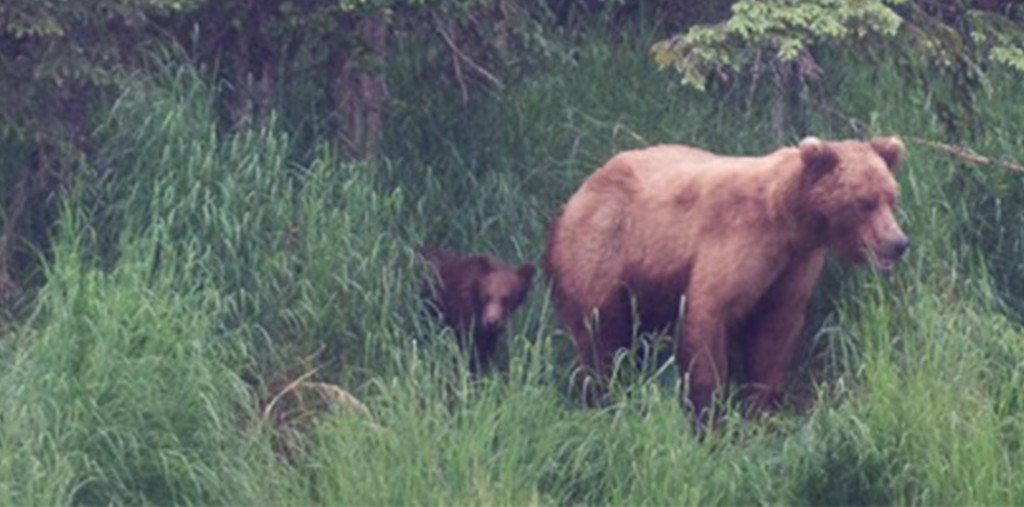By Mike Fitz
As the smallest and most vulnerable of all bears, first year cubs (also called spring cubs or cubs-of-the-year) face significant risks and challenges, not the least of which are larger bears. On July 3, Katmai National Park ranger Andrew LaValle and I were hosting a live broadcast from Brooks Falls. About 40 minutes into the broadcast, we watched Brooks River’s most dominant bear, 856, chase another large male bear, 634 Popeye, downstream and out of our line of sight. Just a few minutes later and off camera, 856 encountered a mother bear and two spring cubs. He then attacked one of the cubs and killed it. The death is a powerful illustration of risk and danger in the bears’ world.
So focused on the waterfall in front of us, neither Andrew nor I saw or heard anything that even hinted at the event unfolding less than a hundred yards away, but a group of park visitors and employees witnessed the attack at the riffles platform, an elevated wildlife-viewing platform downstream of the falls. They saw 856 encounter 132 after he broke off his chase with 634 Popeye. 856 then saw the cub and attacked. 132 tried to defend her cubs but was overpowered by the much larger 856, who quickly returned to the injured cub and killed it. 132’s other cub escaped up a spruce tree, where it remained for about two hours.
856’s motivation in this instance isn’t entirely clear. He didn’t eat it, so hunger might not have played a strong role. Some biologists hypothesize that mate recognition influences the frequency of infanticide in certain species. Male bears may recognize former mates and kill cubs from unfamiliar females to reduce future competition for themselves and their kin. They may also be motivated to sire more offspring. Killing all cubs from a litter can cause a female bear to enter estrus and potentially be available to mate again. Importantly, the instinct to attack vulnerable animals, even if it leads to infanticide, might simply be a trait of many bears. In 2013, the bearcams captured footage of 402 defending her cubs from 813, an adult female, after 813 began to pursue one of 402’s cubs as it fell over Brooks Falls.
For the mother, the cub’s death represents a significant loss. She’s devoted considerable time and energy into caring for it, and 132 risked severe injury, even death, when she tried to defend her cub from 856. Mother bears seem to recognize the risk posed by other bears, which could be the main reason why many females avoid bringing their spring cubs near the falls. However, the possible reward of abundant salmon can be a powerful motivator for a mother who’s trying to meet the nutritional demands of her cubs and satisfy her own insatiable hunger.
Under the circumstances, the infanticide seemed to be a product of chance. Bears appear conditioned to attack vulnerable prey, even if it doesn’t necessarily lead to a meal. 856, perhaps perceiving the cub’s vulnerability, took advantage of a situation where the cub couldn’t defend itself or flee. Bears also show no empathy for their prey. It’s easy to see salmon suffering under the claws and teeth of hungry bears, such as when bears tear the skin off of living salmon. These events certainly aren’t committed under malice or cruelty, as bears live outside our morals, ethics, and the other values that help define our sense of right and wrong.
When I left Brooks Falls at 10 p.m. on July 3, 132’s remaining spring cub had just climbed out of its sanctuary in the spruce tree. It continued to bawl as it walked farther into the forest. As I departed, I caught a glimpse of 132 sniffing at the same tree where the cub found temporary safety. She then walked in the direction the cub had taken shortly before. Now, we know that 132 was reunited with her remaining cub.
Brown bears live in a fierce and competitive world, and spring cubs are the most vulnerable of all bears. Through luck, skill, and the guidance of their mothers, cubs can grow into healthy independent bears. It’s a risky and challenging world though, one in which cubs, their mothers, and the river’s most dominant bears all compete to survive within.



